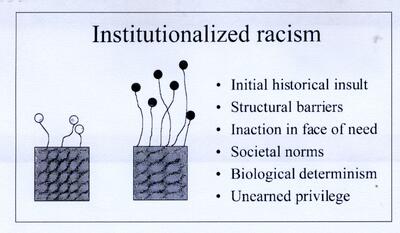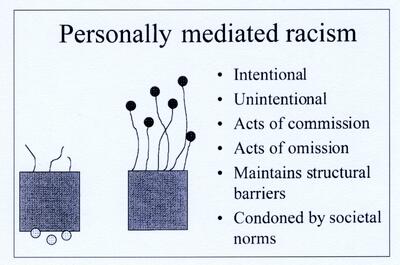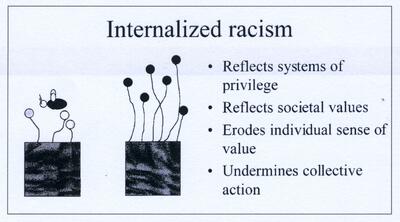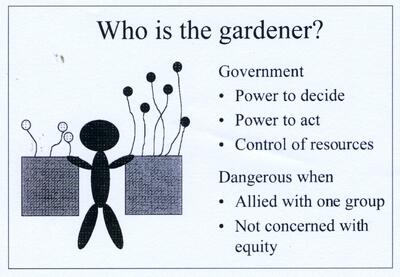Levels of racism: a theoretic framework and a gardener's tale. (nih.gov)
10936998.pdf (nih.gov)
Race-associated differences in health outcomes are routinely documented in this country, yet for the most part they remain poorly explained. Indeed, rather than vigorously exploring the basis of the differences, many scientists either adjust for race or restrict their studies to one racial group. Ignoring the etiologic clues embedded in group differences impedes the advance of scientific knowledge, limits efforts at primary prevention, and perpetuates ideas of biologically determined differences between the races. The variable race is only a rough proxy for socioeconomic status, culture, and genes, but it precisely captures the social classification of people in a race-conscious society such as the United States. The race noted on a health form is the same race noted by a sales clerk, a police officer, or a judge, and this racial classification has a profound impact on daily life experience in this country. That is, the variable “race” is not a biological construct that reflects innate differences, but a social construct that precisely captures the impacts of racism. For this reason, some investigators now hypothesize that race-associated differences in health outcomes are in fact due to the effects of racism. In light of the Department of Health and Human Services’ Initiative to Eliminate Racial and Ethnic Disparities in Health by the Year 2010,7,8 it is important to be able to examine the potential effects of racism in causing race-associated differences in health outcomes.
Levels of Racism
I have developed a framework for understanding racism on 3 levels: institutionalized, personally mediated, and internalized. This framework is useful for raising new hypotheses about the basis of race-associated differences in health outcomes, as well as for designing effective interventions to eliminate those differences. In this framework, institutionalized racism is defined as differential access to the goods, services, and opportunities of society by race. Institutionalized racism is normative, sometimes legalized, and often manifests as inherited disadvantage. It is structural, having been codified in our institutions of custom, practice, and law, so there need not be an identifiable perpetrator. Indeed, institutionalized racism is often evident as inaction in the face of need. Institutionalized racism manifests itself both in material conditions and in access to power. With regard to material conditions, examples include differential access to quality education, sound housing, gainful employment, appropriate medical facilities, and a clean environment. With regard to access to power, examples include differential access to information (including one’s own history), resources (including wealth and organizational infrastructure), and voice (including voting rights, representation in government, and control of the media). It is important to note that the association between socioeconomic status and race in the United States has its origins in discrete historical events but persists because of contemporary structural factors that perpetuate those historical injustices. In other words, it is because of institutionalized racism that there is an association between socioeconomic status and race in this country. Personally mediated racism is defined as prejudice and discrimination, where prejudice means differential assumptions about the abilities, motives, and intentions of others according to their race, and discrimination means differential actions toward others according to their race. This is what most people think of when they hear the word “racism.” Personally mediated racism can be intentional as well as unintentional, and it includes acts of commission as well as acts of omission. It manifests as lack of respect (poor or no service, failure to communicate options), suspicion (shopkeepers’ vigilance; everyday avoidance, including street crossing, purse clutching, and standing when there are empty seats on public transportation), devaluation (surprise at competence, stifling of aspirations), scapegoating (the Rosewood incident, the Charles Stuart case, the Susan Smith case), and dehumanization (police brutality, sterilization abuse, hate crimes). Internalized racism is defined as acceptance by members of the stigmatized races of negative messages about their own abilities and intrinsic worth. It is characterized by their not believing in others who look like them, and not believing in themselves. It involves accepting limitations to one’s own full humanity, including one’s spectrum of dreams,one’s right to self determination,and one’s range of allowable self expression. It manifests as an embracing of “whiteness”(use of hair straighteners and bleaching creams, stratification by skin tone within communities of color, and “the white man’s ice is colder” syndrome); self-devaluation (racial slurs as nicknames, rejection of ancestral culture, and fratricide); and resignation, helplessness, and hopelessness (dropping out of school, failing to vote, and engaging in risky health practices). The following allegory is useful for illustrating the relationship between the 3 levels of racism (institutionalized, personally mediated, and internalized) and for guiding our thinking about how to intervene. I use this story in my teaching on “race” and racism at the Harvard School of Public Health as well as in my public lectures.

Levels of Racism: A Gardener’sTale
When my husband and I bought a house in Baltimore, there were 2 large flower boxes on the front porch. When spring came we decided to grow flowers in them. One of the boxes was empty, so we bought potting soil to fill it. We did nothing to the soil in the other box, assuming that it was fine. Then we planted seeds from a single seed packet in the 2 boxes. The seeds that were sown in the new potting soil quickly sprang up and flourished. All of the seeds sprouted, the most vital towering strong and tall, and even the weak seeds made it to a middling height. However, the seeds planted in the old soil did not fare so well. Far fewer seeds sprouted, with the strong among them only making it to a middling height, while the weak among them died. It turns out that the old soil was poor and rocky, in contrast to the new potting soil, which was rich and fertile. The ference in yield and appearance in the 2 flower boxes was a vivid, real-life illustration of the importance of environment.Those readers who are gardeners will probably have witnessed this phenomenon with their own eyes. Now I will use this image of the 2 flower boxes to illustrate the 3 levels of racism. Let’s imagine a gardener who has 2 flower boxes, one that she knows to be filled with rich, fertile soil and another that she knows to be filled with poor, rocky soil. This gardener has 2 packets of seeds for the same type of flower. However, the plants grown from one packet of seeds will bear pink blossoms, while the plants grown from the other packet of seeds will bear red blossoms. The gardener prefers red over pink, so she plants the red seed in the rich fertile soil and the pink seed in the poor rocky soil. And sure enough, what I witnessed in my own garden comes to pass in this garden too. All of the red flowers grow up and flourish, with the fittest growing tall and strong and even the weakest making it to a middling height. But in the box with the poor rocky soil, things look different. The weak among the pink seeds don’t even make it, and the strongest among them grow only to a middling height. In time the flowers in these 2 boxes go to seed, dropping their progeny into the same soil in which they were growing. The next year the same thing happens, with the red flowers in the rich soil growing full and vigorous and strong, while the pink flowers in the poor soil struggle to survive. And these flowers go to seed. Year after year, the same thing happens. Ten years later the gardener comes to survey her garden. Gazing at the 2 boxes, she says, “I was right to prefer red over pink! Look how vibrant and beautiful the red flowers look, and see how pitiful and scrawny the pink ones are"

This part of the story illustrates some important aspects of institutionalized racism. There is the initial historical insult of separating the seed into the 2 different types of soil; the contemporary structural factors of the flower boxes, which keep the soils separate; and the acts of omission in not addressing the differences between the soils over the years. The normative aspects of institutionalized racism are illustrated by the initial preference of the gardener for red over pink. Indeed, her assumption that red is intrinsically better than pink may contribute to a blindness about the difference between the soils.

Where is personally mediated racism in this gardener’s tale? That occurs when the gardener, disdaining the pink flowers because they look so poor and scraggly, plucks the pink blossoms off before they can even go to seed. Or when a seed from a pink flower has been blown into the rich soil, and she plucks it out before it can establish itself. And where is the internalized racism in this tale? That occurs when a bee comes along to pollinate the pink flowers and the pink flowers say, “Stop! Don’t bring me any of that pink pollen—I prefer the red!” The pink flowers have internalized the belief that red is better than pink, because they look across at the other flower box and see the red flowers strong and flourishing.
What are we to do if we want to put things right in this garden? Well, we could start by addressing the internalized racism and telling the pink flowers, “Pink is beautiful!” That might make them feel a bit better, but it will do little to change the conditions in which they live. Or we could address the personally mediated racism by conducting workshops with the gardener to convince her to stop plucking the pink flowers before they have had a chance to go to seed. Maybe she’ll stop, or maybe she won’t. Yet, even if she is convinced to stop plucking the pink flowers, we have still done nothing to address the poor, rocky condition of the soil in which they live.
What we really have to do to set things right in this garden is address the institutionalized racism. We have to break down the boxes and mix up the soil, or we can leave the 2 boxes separate but fertilize the poor soil until it is as rich as the fertile soil. When we do that, the pink flowers will grow at least as strong and vibrant as the red (and perhaps stronger, for they have been selected for survival).And when they do, the pink flowers will no longer think that red pollen is better than pink, because they will look over at the red flowers and see that they are equally strong and beautiful. And although the original gardener may have to go to her grave preferring red over pink, the gardener’s children who grow up seeing that pink and red are equally beautiful will be unlikely to develop the same preferences.
This story illustrates the relationship between the 3 levels of racism. It also highlights the fact that institutionalized racism is the most fundamental of the 3 levels and must be addressed for important change to occur. Finally, it provides the insight that once institutionalized racism is addressed, the other levels of racism may cure themselves over time.

Perhaps the most important question raised by this story is Who is the gardener? After all, the gardener is the one with the power to decide, the power to act, and the control over the resources. In the United States, the gardener is our government. As the story illustrates, there is particular danger when this gardener is not concerned with equity. The current Initiative to Eliminate Racial and Ethnic Disparities in Health by the Year 2010 is to be lauded as the first explicit commitment by the government to achieve equity in health outcomes. Many other questions arise from this simple story. What is the role of public health researchers in vigorously exploring the basis of pink–red disparities, including the differences in the soil and the structural factors and acts of omission that maintain those differences? How can we get the gardener to own the whole garden and not be satisfied when only the red flowers thrive? If the gardener will not invest in the whole garden, how can the pink flowers recruit or grow their own gardener? The reader is invited to share this story with family members, neighbors, colleagues, and communities. The questions we raise and the discussions we generate may be the start of a much-needed national conversation on racism.

